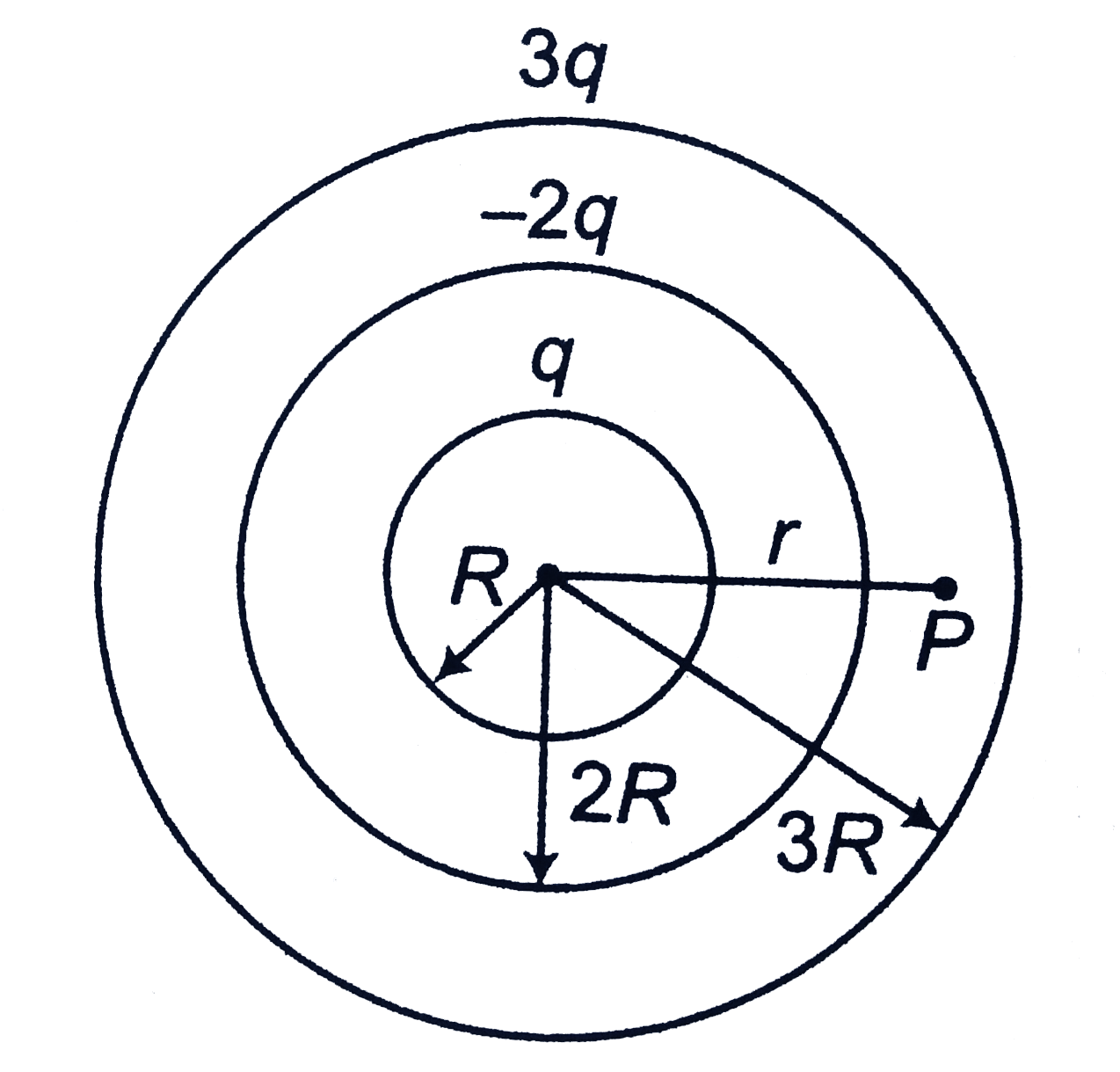A solid spherical region, having a spherical cavity whose diameter R is equal to the radius of the spherical region, has a total charge Q. Find the electric field at a point P as shown in figure
 .
.
Q18πε0⎡⎢ ⎢ ⎢⎣4x2−1(x−R2)2⎤⎥ ⎥ ⎥⎦
Q28πε0⎡⎢ ⎢ ⎢⎣8x2−1(x−R2)2⎤⎥ ⎥ ⎥⎦
Q28πε0[8x2−1(x−R)2]
Q18πε0[4x2−1(x−R)2]
The correct Answer is:B
Volumetric charge density of given structure is
ρ=Q43πR3−43π(R2)3=87Q43πR3

1Q1=ρ43πR3=87Q,Q2=ρ43π(R2)3=17Q
EP=E1−E2=14πε0Q1x2−14πε0Q2(x−R2)2
=Q28πε0⎡⎢
⎢
⎢⎣8x2−1(x−R2)2⎤⎥
⎥
⎥⎦.
Topper's Solved these Questions
- ELECTRIC FLUX AND GAUSS LAWBOOK - CENGAGE PHYSICSCHAPTER - ELECTRIC FLUX AND GAUSS LAWEXERCISE - Single Correct
40 Videos
- ELECTRIC FLUX AND GAUSS LAWBOOK - CENGAGE PHYSICSCHAPTER - ELECTRIC FLUX AND GAUSS LAWEXERCISE - Multiple Correct
8 Videos
- ELECTRIC FLUX AND GAUSS LAWBOOK - CENGAGE PHYSICSCHAPTER - ELECTRIC FLUX AND GAUSS LAWEXERCISE - Exercise 2.2
14 Videos
- ELECTRIC CURRENT AND CIRCUITBOOK - CENGAGE PHYSICSCHAPTER - ELECTRIC CURRENT AND CIRCUITEXERCISE - Interger
8 Videos
- ELECTRIC POTENTIALBOOK - CENGAGE PHYSICSCHAPTER - ELECTRIC POTENTIALEXERCISE - DPP 3.5
14 Videos
Similar Questions
A solid spherical region having a spherical cavity whose daimeter R is equal to the radius of the spherical region, has a total charge 'Q'. Find the electric field and potential at a point P as shown.

View SolutionA solid spherical region having a spherical cavity. whose diameter R is equal to the radius of the spherical region, has a total charge Q. The electric field at a point P as shown is Q28πɛ0⎡⎢ ⎢ ⎢⎣Ax2−B(x−R2)2⎤⎥ ⎥ ⎥⎦. Find (A−B).
'(##CEN_KSR_PHY_JEE_C18_E01_029_Q14##)'
View Solution
Knowledge Check
Three conducting spherical shells have charges q,−2q and 3q as shown in figure. Find electric Potential at point P as shown in figure.
 Akq(12r−1r)Bkq(1R−1r)Ckq(12R−1r)Dkqr−k(2q)r+k3qR
Akq(12r−1r)Bkq(1R−1r)Ckq(12R−1r)Dkqr−k(2q)r+k3qR
Here =kq(1R−1r)A spherical shell of radius R has a charge +q units. The electric field due to the shell at a point
Ainside is zero and varies as r−1 outside itBinside is constant and varies as r−2Cinside is zero and varies as r−2 outside itDinside is constant and varies as r−1 outside itA spherical shell of radius R has a uniformly distributed charge ,then electric field varies as
Ainside is zero and varies as x−1 outside itBinside is non zero constant and varies as x2 outside itCinside is zero and varies as x−2 outside itDinside is constant and varies as x−1 outside it
Electric charge q is uniformly distributed in a spherical space from which a cavity of diameter equal to the radius R of the spherical space has been removed. Calculate the potential and field at a point P lying on the diameter of the cavity at a distance r>r/2 but lt R from the centre of the sphere.
View SolutionThe adjacent diagram shows a charge +Q held on an insulating support S and enclosed by a hollow spherical conductor,O represent the center of the spherical conductors and P is a point such that OP=x and SP=r .The electric field at point P will be

View SolutionA sphere of radius R has a uniform volume density ρ. A spherical cavity of radius b, whose center lies at →a, is removed from the sphere.
i. Find the electric field at any point inside the spherical cavity.
ii. Find the electric field outside the cavity
(a) at points inside the large sphere but outside the cavity and
(b) at points outside the large sphere.

View SolutionGiven below are two statements :
Statement I : An electric dipole is placed at the centre of a hollow sphere. The flux of electric field through the sphere is zero but the electric field is not zero anywhere in the sphere.
Statement II : If R is the radius of a solid metallic sphere and Q be the total charge on it. The electric field at any point on the spherical surface of radius r(<R) is zero but the electric flux passing through this closed spherical surface of radius r is not zero.
In the light of the above statements, choose the correct answer from the options given below :
View SolutionA solid metallic sphere has a charge +3Q. Concentric with this sphere is a conducting spherical shell having charge −Q. The radius of the sphere is a and that of the spherical shell is b(b>a) What is the electric field at a distance R(a<R<b) from the centre
View Solution
